Cover Crop Walk
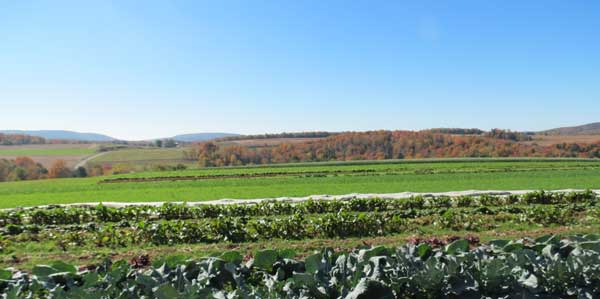
Thanks to field day participants, Sarah Bay, Dawn Blanchard and Gregory Hartt, we can share photos from the 2015 cover crop walk. The first two images below show the substantial difference in growth between oats planted in early August (Field 7) and oats planted a month later (Field 3).
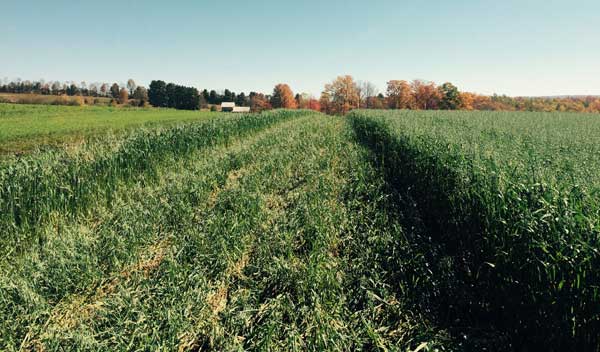
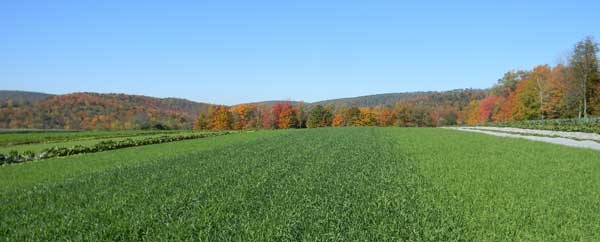
The difference in biomass is also documented in the cover crop chart put together for the farm tour by Penn State grad student, Abbe Hamilton. As part of her multi–faceted research project, she collected and processed over 1,000 cover crop samples from Pennsylvania farms.
Abbe’s cover crop data include the oats planted on our farm. (The seeding dates and rates are almost identical to the 2015 oat cover crops shown in the photos.) Both the August and September planting dates resulted in over 90 percent ground cover by the end of October. However, the later planted oats produced half as much dry matter and much less ground cover the next spring. The reduction in ground cover is partly due to this succulent, winter–killed residue, which contains a relatively high percent of nitrogen, decomposing quickly and releasing its nutrients. This is an ideal cover crop scenario for minimum-till onions, especially if the oats are planted on ridges to enhance soil warming and drainage.
By contrast, the much higher carbon–to–nitrogen ratio of the earlier planted oats slows down decomposition and nutrient release. We think this mature oat residue makes a better in-situ mulch for fall planted garlic. (Details on planting the low–till aliums and oat cover crops in the next issue.)
Neither the early nor late planted oats produce a thick enough mulch to preserve moisture for our unirrigated vegetables. For years we purchased wheat straw to supplement the winter–killed cover crop. Now we grow additional cover crop mulch right next to the onions and garlic.
The second photo shows a 20–foot wide strip of rye established on either side of the late planted oats. At the end of May the next year, when the rye is 5 to 6 feet tall and dropping pollen, we mow it with our McCormick No. 7 sicklebar mower, rake the straw into windrows with the New Idea side delivery hay rake, then move the windrows in to the pathways of the onions by hand. Unlike baled straw, the longstem rye does not blow away in a stiff wind and is much slower to decay. Growing our own mulch also saves time and expense while reducing the risk of importing weed seeds or volunteer grain.
| Cover Crop |
Planting Date |
Sampling Date | Percent Cover | Dry Biomass (#/ac) | Percent N | Pounds N/ac | Percent Carbon | Pounds C/ac | C:N ratio |
| Oats on ridges |
8/5/14 | 10/13/14 | 88% oat, 3% dead, 9 % bare |
3712 | 1.82 | 68 | 41.7 | 1548 | 23:1 |
| Early April 2015 |
97% dead, 3% bare |
||||||||
| Oats on ridges | 9/5/14 | 10/13/14 | 97% cover, 3% bare |
1863 | 3.52 | 65.5 | 43.3 | 807 | 12:1 |
| Early April 2015 |
65% dead, 35% bare |
||||||||
| Rye | 9/5/14 | 10/30/14 | 97%cover, 3% bare |
2153 | 3.89 | 36.5 | 43.6 | 939 | 11:1 |
| 5/27/15 | 100% rye | 5863 | 1.2 | 70 | 45.1 | 2644 | 38:1 | ||
| Sweet Clover |
7/16/14 | 10/30/14 | 86% clover, 10% volunteer 4% bare |
1885 | 2.7 | 51 | 43.7 | 824 | 16:1 |
| 5/27/15 | 100% clover | 3616 | 3.2 | 116 | 43.7 | 1580 | 14:1 | ||
| Sweet Clover |
7/10/13 | 5/24/2014 | no sample | 3222 | 4.2 | 135 | 40.8 | 1315 | 10:1 |
| Red Clover | 6/17/13 | 5/24/15 | no sample | 2250 | 4.1 | 92 | 41.5 | 934 | 10:1 |
| Red Clover | 6/17/13 | 5/24/15 | no sample | 1740 | 4.1 | 71 | 41.1 | 715 | 10:1 |
We should point out that growing large biomass cover crops can be a liability. Plowing down the 5 to 6-foot tall rye with a C:N ratio of 38:1 would be a sure recipe for nitrogen tie–up. That is, the microbes would deplete nitrogen in the soil to breakdown this high carbon material, depriving vegetables of this critical nutrient in the process.
Nitrogen tie–up can be prevented by applying fertilizer or manure to the mature rye before turning it under and then allowing a month or more for decomposition before planting the produce. It can also be avoided by replacing this small grain cover crop with a legume, like hairy vetch or clover, which contains a C:N ratio closer to 12:1 at maturity. Abbe’s chart shows that yellow blossom sweet clover produced a good bit of biomass by the end of May while maintaining a relatively high percent of nitrogen.
The most impressive fall vegetables on our farm in 2015 followed a plowdown of high nitrogen sweet clover and were mulched right after planting with the adjacent cover crop of high carbon rye. Keeping this high C:N mulch on the surface preserves moisture while minimizing nitrogen tie–up because only a small portion of the residue is in contact with the soil and the decomposing microbes.
Whether nitrogen–fixing legumes or carbon–fixing grains, growing big biomass cover crops takes time. One reason we fallow half of the market garden each year is to provide plenty of time and space for cover cropping. Typically, we grow two cover crops in the fallow fields sandwiching a bare fallow period midsummer to flush weeds out of the soil.
For instance, in 2015, we started out Field 5 with a cover of rye (planted after vegetable harvest the previous fall) which we used for mulching the vegetables in nearby fields. We followed the rye with a brief period of shallow tillage before planting the second cover crop, a mix of rye, hairy vetch and medium red clover. The fall cover crop of oats in Fields 3 and 7 were preceded by a spring cover crop of forage peas. In Field 1, a mix of sorghum–sudangrass, medium red clover and yellow blossom sweet clover followed hairy vetch interseeded in the previous year’s vegetables.

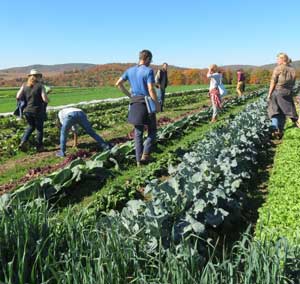
Field day participants seemed intrigued with the interseeding of vetch in Fields 2 and 4. We seeded the single row of hairy vetch in the middle of the pathways with the walk–behind Planet Jr. three to four weeks after planting the fall vegetables. The three to four week delay prevents this low–growing, living mulch from crawling up on top of the crops or competing with the vegetables for moisture or nutrients.
The leguminous living mulch does not suppress weeds. Devoting half of the market garden each year to cover crops and bare fallow periods has reduced weed pressure to the point we can use this single row interseeding system without compromising weed management. When asked how many buckets of weeds we had removed from Field 2, we explained that we Looking at the spinach and vetch underneath the Proteknet had cultivated the crops in this half-acre field once right before seeding the vetch in August, spent three to four hours hoeing in September, and filled one nail apron with chickweed that threatened to go to seed.
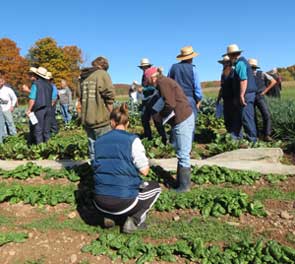

Walking through Field 2, people asked questions about how we will manage the crop residue and interseeding of vetch the next year. We looked at the coulter and tooth setup on the McCormick- Deering cultivator used for no–tilling the garlic and described how it can be used for undercutting the crops and living mulch with the addition of a wide sweep and ridging shovel.
As for the timing of undercutting, it really depends on the condition of the fallow field in the spring. If the hairy vetch overwinters in good shape and the field is weed free, then we will let the vetch grow until it is in full flower before killing it. However, if some of the vetch dies out over winter or a good number of weeds are present, then we will undercut the fallow field in April and replant it to a spring cover crop like forage peas or barley.
The second cover crop in the fallow field is determined by the planting window of the cash crops the next year. Before spring vegetables, we use cover crops that will reliably winterkill at our north–central Pennsylvania location, such as oats, forage peas, sorghum-sudangrass, crimson clover and Japanese millet. In preparation for summer and fall produce, we can broaden the cover crop selection to include rye, hairy vetch and clover because there will be plenty of time to kill these overwintering cover crops before planting the vegetables.
| FIELD 1 | FALLOW year before 2016 fall vegetables 7/17 sorghum-sudangrass at 100 lbs/ac, medium red clover at 25 lbs/ac and sweet clover at 20 bs/ac |
| FIELD 2 | Fall VEGETABLES 8 lbs/ac13 and 8/24 interseeded vetch at 15 lbs/ac and 18 lbs/ac |
| FIELD 3 | FALLOW year before 2016 onions and fall vegetables |
| FIELD 4 | ONIONS and Fall VEGETABLES 8/25 interseeded vetch at 18 lbs/ac in fall vegetables (north and south sides of field) 9/22 rye at 180 lbs/ac after onions (middle of the field) |
| FIELD 5 | FALLOW year before 2016 summer vegetables 8/5 rye at 90 lbs/ac, vetch at 40 lbs/ac and medium red clover at 20 lbs/ac |
| FIELD 6 | Spring VEGETABLES 8/25 rye at 140 lbs/ac (north half) 9/8 rye at 180 lbs/ac after potatoes (south half) |
| FIELD 7 | FALLOW year before 2016 garlic and spring vegetables 8/4 oats at 3-1/2 bu/ac (7 ridges on north side for no-till garlic) |
| FIELD 8 | Summer VEGETABLES 7/16 sweet clover at 30 lbs/ac (south side of field) 9/17 rye at 180 lbs/ac |
Fields 1-8 are approximately 1/2 acre in size. We also crop four fields that are 1/3 acre pus a countour strip which is 2/3 acre, totalling 6 acres (half vegetables, half fallow) under dryland cutivation. We rotate our moveable hoophouses over another 1/3 acre where we have access to irrigation.
More details on their bio-extensive system can be found in their Weed the Soil, Not the Crop booklet ($10 plus $3 s/h) and DVD ($15 plus $3 s/h). Please send payments to Anne or Eric, 3410 Rt 184, Trout Run, PA 17771.
